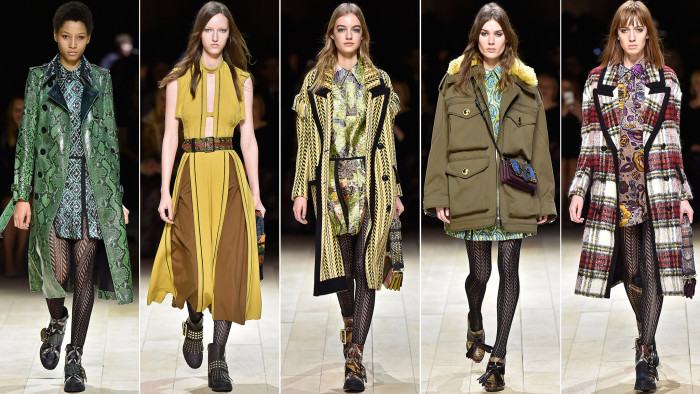Burberry AW16 show report London Fashion Week

Simply sign up to the Life & Arts myFT Digest -- delivered directly to your inbox.
And so to Burberry and its AW16 show. Which in fact, was only part one: the second AW16 show will take place in September and will initiate the brand’s plans to sell straight from the catwalk. Most of these autumn clothes, seen in February, would be arriving in stores in June and July, and all under the banner of the Burberry brand. The company has now merged its former Prorsum, London and Brit divisions into one and they would very much encourage you to forget they ever existed.
Streamlining a brand can be terribly confusing. Last November, following half-year reports of a 9 per cent increase in pre-tax profits at the house within a “challenging” environment, Carol Fairweather, Burberry’s finance director, indicated the brand would cut costs by about £20m this year in hiring and expenses. Growth has plateaued for many luxury labels in the wake of the Asian slowdown, with sales becoming sluggish and new markets proving frustratingly unpredictable. Burberry’s latest announcement, however, has recast its claim to being one of fashion’s most dynamic, responsive and consumer-facing brands. They sound active and engaged, even if ready-to-buy has in practice already been adopted by many in the industry, albeit in a quieter way.
“It’s doing what feels right for our audience,” explained Christopher Bailey, Burberry chief creative and executive officer, of his decision to launch the “see now buy now” strategy. “It wasn’t supposed to be a ground shift within the industry. Or even that radical. But we’re in an industry which is supposed to embrace change and so this format felt like part of that journey. Burberry were early to digital and it didn’t feel right to have invited our audience in [the brand has 38 million social media followers across 19 global platforms, many of whom were following the show on Twitter, Snapchat and Instagram] and then not conform to that.”
Bailey’s focus since becoming chief executive in May 2014 has been to simplify the brand’s message: from now on there will be only two show collections (showing both men’s and women’s in each), two seasons and one label. It is a simplification that makes total sense for the Google-generation.

Right brain sorted, how would the creative left compare? As chief creative officer, Bailey’s AW16 collection was his loosest yet. In past seasons, his collections have followed fairly straight artistic themes — Bloomsbury watercolourists, perhaps, or military frogging. This was a mélange of different ideas — and varying price points — as the designer offered a “patchwork of the things I really love”. Conveniently enough, the patchwork was stitched together with many of the Burberry codes: tufty blanket coats in its scarf plaids, military outerwear with bold button details, oversized shearlings, duffle coats and parkas and Mitford-sister era gowns. Bailey had drawn on his love of “musical references”: there were glam rock era shiny metallic lamés and lurex tops, technicolour brocades and bright sequinned floral mini-dresses. Snakeskin and patent details patterned outerwear and pockets.
In view of the fact these clothes would be delivered in stores simultaneously “in very hot and very cold climates”, Bailey had mixed in “big heavy cashmeres with very light dresses”. The shoes were chunky and stack-heeled and there were smaller bags stitched in a tapestry of coloured skins.
This collection will inform the next, said Bailey and as such this trans-seasonal offering was the beginning of an emerging line that will be less flexible from one season to the other. It is no easy route Bailey takes. But perhaps that is the irony in simplifying things, you end up having to doing twice as much.
Photographs: Catwalking.com
Comments